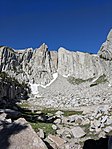Granite Mountain (Salt Lake County, Utah)
Archives in the United StatesBuildings and structures in Salt Lake County, UtahGenealogy and the Church of Jesus Christ of Latter-day SaintsLatter Day Saint movement stubsMountains of Salt Lake County, Utah ... and 4 more
Mountains of UtahSignificant places in MormonismThe Church of Jesus Christ of Latter-day Saints in UtahWasatch Range
Granite Mountain is a mass of solid rock one mile up Little Cottonwood Canyon in the Wasatch Range of Utah, not too far from Salt Lake City, Utah. Despite its name, Granite Mountain is primarily composed of quartz monzonite, an igneous rock similar to granite in appearance, physical characteristics, and chemical composition. This is the same material used to construct the Salt Lake Temple and the facade of the LDS Conference Center.
Excerpt from the Wikipedia article Granite Mountain (Salt Lake County, Utah) (License: CC BY-SA 3.0, Authors).Granite Mountain (Salt Lake County, Utah)
Little Cottonwood Road,
Geographical coordinates (GPS) Address Nearby Places Show on map
Geographical coordinates (GPS)
| Latitude | Longitude |
|---|---|
| N 40.573143 ° | E -111.763413 ° |
Address
Little Cottonwood Road
84092
Utah, United States
Open on Google Maps







